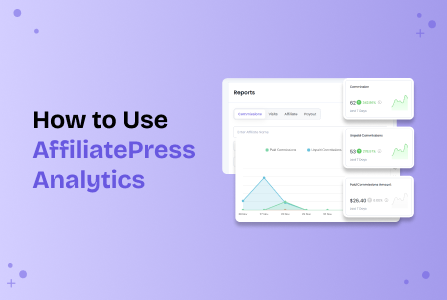PPC vs PPL vs PPS: What to Choose for Affiliate Program

Launching an affiliate program is impossible without deciding on the commission type that can bring you the best value. You can even alter it in the middle of your journey if you notice the ineffectiveness of the current setup. How to decide which commission type you need right now?
How do the key ones, such as pay-per-lead, pay-per-click, and pay-per-conversion, work and help you earn affiliates’ trust and money for your business?
In this article, we’re exploring commission structures and what results they can bring you, what values and risks they have, and how to choose the right one.
Pay-Per-Lead vs Pay-Per-Click and Pay-Per–Conversion: What’s the Difference?

First of all, let’s clarify the difference between these popular commission structures used in various affiliate marketing programs to reward affiliate partners.
These are all ways to track affiliate partner activities and pay them respectively.
Pay-per-conversion (PPC), also known as pay-per-sale (PPS), is probably the simplest type to understand and track properly. An affiliate is paid based on the actual amount of money they generated. More risk on the affiliate, but it’s really safer for the business, creating tangible ROI opportunities for your business.
Pay-per-lead (PPL) is a bit more complex than pay-per–conversion, since the concept of “lead” must be clearly defined and tracked inside your program and website. It can be anything like a trial, demo, or newsletter opt-in. For instance, online schools can pay affiliates $10–$50 per form filled by a potential student. Valid conditions play a role here to make sure leads are of high quality.
For example, a specific region or a valid email address. Moreover, tracking such leads is usually a more complex and resource demanding process, even with trusted affiliate software.
Pay-per-click (PPC) is more widely used in social media (Facebook Ads, Instagram Ads, LinkedIn Ads) and marketing and search engine ads (Google Ads, Bing Ads). You’ve probably also seen those (sometimes non skippable) video ads on YouTube, which might be also set as PPC. In affiliate marketing, PPC can be used to drive traffic to affiliate landing pages or blogs.
As a business, you can also decide to pay affiliates per just a click (not a sale or lead), but a specialized software that supports this option is required. It’s perfect for affiliates because they don’t need to worry about sending you real conversions, but there is no guarantee of sales for you (you can be just wasting your money, and we’ll talk about the risks later in the post).
How to Decide Which Commission Type is For You

The first important thing is to analyze your own business to come up with the best commission structure.
The commission type you choose depends heavily on your business model, sales cycle, customer value, and margins.
Typical e-commerce for physical products often uses a per sale commission (e.g. 20%) because such a fixed percentage allows easier alignment of commissions with actual revenue.
Lead focused industries, for example, insurance, real estate, finance, or education often leverage cost per lead (CPL) or cost per action (CPA) structures. Travel and hospitality industries can also use pay-per-lead commissions that lead to customer sign up and can potentially generate revenue in the future.
Sales cycles in these kinds of businesses can drag on, so they often consider it’s worth paying for qualified leads (form submissions or trial signups). For example, they might pay a $50 commission to an affiliate for a student inquiry.
On the other hand, one business can have a variety of commissions based on the product or service. For example, margins in music (e.g., digital downloads, merch, instruments, streaming subscriptions) are often moderate to low.
Big marketplaces often offer a revenue share on transaction fees. For example, Apple as an app store offers affiliates different commission types based on the digital services:
- Music – 7% commission on sales revenue.
- Fitness – one time payment on an annual or monthly subscription.
- TV – one time payment on membership.
As you see, affiliates only earn small amounts per sale (e.g., $0.70 on a $10 album), but that lets Apple keep commission costs predictable and sustainable.
Subscription based businesses can also have very different approaches. For instance, fitness memberships (apps, gyms, online classes) usually rely on long term retention to generate profits; thus, they are quite on the safe side with the pay per lead conversions. This approach is a proven way to scale your business through an affiliate program pretty quickly when acquiring new users.
A one time payment (e.g., $30–$50 per signup) rewards affiliates immediately without ongoing costs.
Affiliate motivation is also an important factor in choosing a commission type. Scenarios vary, again, based on the affiliate’s goals and approach. Very common cases include:
- A commission is attractive if the payout per signup is meaningful.
- Affiliates are oftentimes searching for instant rewards rather than specific commission structures or types.
- Top affiliates also often want to share long term revenue.
- When selling memberships and subscriptions, affiliates might be interested in driving trial signups or seasonal campaigns.
So, finding the right balance between the right commission structure and affiliate motivation is crucial.
Pay–Per-Lead vs Pay-Per-Click vs Pay-Per-Conversion: What Exactly Do You Risk?

Of course, every commission structure poses risks, and they are more present when not balanced with the product or business type correctly.
For instance, music streaming services may offer the pay-per-lead commission (PPL), but since it may be really hard to track link validity without the proper affiliate marketing software, fake or unqualified leads can be the outcome you don’t want. And you paid before even generating any revenue!
Pay-per-click (PPC) affiliate commissions are probably the most vulnerable and prone to click fraud, which can never convert to links or sales, especially if built via manipulative strategies like irrelevant keyword stuffing. Then you risk paying affiliates a lot with little ROI.
Pay-per-conversion (PPS/CPA) is of the lowest risk because you pay only when there is a real sale. Most reputable affiliate software, such as AffiliatePress, uses this commission type, which is the safest, most accurate, and most profitable for businesses. Moreover, AffiliatePress lets you decide whether you use a per order or per product percentage/fixed commission.
Tying commissions to the actual money generated is surely the most profitable thing for many retailers and other industries. The risk, however, lies more in the affiliate motivation (delayed cash flow, not enough branding materials, not attractive share).
The Choice of Affiliate Software Matters

No matter which method you choose, tracking happens through affiliate software or plugin using links (through cookies or URL parameters) or other methods like QR codes. However, the software should be able to handle your chosen scenario and commission structure, whether pay-per-lead or per-click, or pay-per-conversion. Make sure to check it out if your commission structure can be brought to life with your software.
With the AffiliatePress plugin, it takes no time to integrate the affiliate management system into your existing WordPress site, whether it’s on WooCommerce or dozens of other plugins that help you sell products, services, or subscriptions.
When it comes to the commission structure, as we’ve already mentioned, you can use the safest method of the per sale or per product commission with the pre defined rate of fixed or percentage based commission. The payouts can be created in clicks using PayPal or Stripe, without delays. Worth trying!
Let’s Conclude
Deciding on the commission type, especially if you are choosing between pay-per-lead or per-click, or pay-per-conversion methods, is crucial for your affiliate program success. There is an important interdependence of many factors you should consider.
Finally, let’s sum up all of them, including the risks and benefits of these commission types.
| Parameters | Pay-Per-Click | Pay-Per-Lead | Pay-Per-Conversion |
| Key Advantage | Fast traffic growth and brand visibility | Pay only for qualified prospects | Pay only when actual revenue is made |
| Key Risk | Click fraud and irrelevant traffic | Fake/low quality leads | Harder to recruit affiliates |
| Ease of Implementation | Easy (Simple click tracking) | Moderate (Needs lead validation) | Moderate to Complex (requires reliable sales tracking) |
| Best For | Startups seeking awareness, content heavy sites | Service businesses, SaaS, subscriptions | E-commerce, travel bookings, high ticket products |
| Profit Opportunities | Low to medium (depends on conversion rates) | Medium–high (if leads convert) | High (best ROI if margins are strong) |
Related articles:





